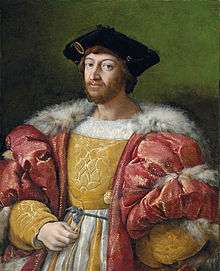Lorenzo de' Medici, Duke of Urbino
Lorenzo di Piero de' Medici (Italian pronunciation: [loˈrɛntso di ˈpjɛːro de ˈmɛːditʃi]; 12 September 1492 – 4 May 1519) was the ruler of Florence from 1516 until his death in 1519. He was also Duke of Urbino during the same period. His daughter Catherine de' Medici became Queen Consort of France, while his illegitimate son, Alessandro de' Medici, became the first Duke of Florence.
Lorenzo II de' Medici | |
|---|---|
 | |
| Lord of Florence | |
| Reign | 17 March 1516 – 4 May 1519 |
| Predecessor | Giuliano de' Medici |
| Successor | Giulio de' Medici |
| Born | 12 September 1492 Florence, Republic of Florence |
| Died | 4 May 1519 (aged 26) Careggi, Republic of Florence |
| Noble family | Medici |
| Spouse(s) | Madeleine de La Tour d'Auvergne |
| Issue | |
| Father | Piero the Unfortunate |
| Mother | Alfonsina Orsini |
Early life
Lorenzo was born in Florence on 12 September 1492, a son of Piero di Lorenzo de' Medici and Alfonsina Orsini.[1] His paternal grandparents were Lorenzo the Magnificent and Clarice Orsini.[1] His maternal grandparents were Roberto Orsini, Count of Tagliacozzo and Catherine San Severino.
In 1510, while the Medici family were living near Rome, a black servant in their household - identified in documents as Simonetta da Collevecchio - gave birth to a son, Alessandro de' Medici, whom Lorenzo officially recognized as his illegitimate son.[2] In 1531, Alessandro de' Medici became Florence's first hereditary monarch.
Career
Lorenzo II became lord of Florence in August 1513, after his uncle, Giuliano de' Medici, handed over control of its government. Ambitious by nature, Lorenzo II lacked patience with Florence's republican system of government, and thus in 1516, convinced his uncle, Pope Leo X to make him Duke of Urbino at the age of 24.[3] So began a conflict with the city's theretofore duke, Francesco Maria I della Rovere. During the protracted War of Urbino, Delle Rovere recaptured the city, only to have Medici – commanding a 10,000-man Papal army – in turn, retake the city. During battle, Lorenzo was wounded, which prompted him to retire to Tuscany. In September 1517, he regained Urbino via treaty; however, it remained under the Medici family's rule for only two years. In 1521 the duchy reverted to the Della Rovere family.[3]
On 13 June 1518, Lorenzo married Madeleine de la Tour, daughter of the Count of Auvergne.[2] The marriage produced a daughter, Catherine, who was born in 1519. Catherine de' Medici went on to become Queen of France, via a marriage to the future King Henry II of France, arranged by the second Medici Pope, Pope Clement VII.[4]
Only 21 days after Catherine de' Medici's birth, Lorenzo II died, "worn out by disease and excess."[5] Thus his daughter Catherine was raised primarily by the Medici Popes, Leo X and Clement VII, and their surrogates.
Lorenzo II's tomb is in the Medici Chapel of Florence's Church of San Lorenzo, adorned by Michelangelo's sculpture Pensieroso, representing the Duke. Its companion piece, also sculpted by Michelangelo, represents Lorenzo II's uncle Giuliano di Lorenzo de' Medici. In sharing the same name with his illustrious ancestor, Lorenzo the Magnificent, the Duke's tomb is often mistaken for that of his grandfather.[6][7]
Famously, Niccolò Machiavelli dedicated his political treatise The Prince to Lorenzo to inform him of tactics to use maintaining his authority.[8]
Ancestry
| Ancestors of Lorenzo de' Medici, Duke of Urbino | ||||||||||||||||||||||||||||||||||||||||||||||||||||||||||||||||||||||||||||||||||||||||||||||||||||||||||||||||||||||||||||||||||||||||||||||||||||||||||||||||||||||||||||||||||||||||||||||||||||||||||||||||||||||||||||||||||||||||||||||||||||||||||||||||||||||||||||||||||||||||||||||||||||||||||||||||||||||||||||||||||||||||||||||||||||||||||||||||||||||||||||||||||||||||||||||||||||||||||||||||||||||||||||||||||||||||||||||||||||||||||||||||||||||||||||||||||||||||||||||||||||||||||||||||||||||||||||||||||||||||||||||||||||||||||||||||||||||||||||||||||||||||||||||||||||||||||||||||
|---|---|---|---|---|---|---|---|---|---|---|---|---|---|---|---|---|---|---|---|---|---|---|---|---|---|---|---|---|---|---|---|---|---|---|---|---|---|---|---|---|---|---|---|---|---|---|---|---|---|---|---|---|---|---|---|---|---|---|---|---|---|---|---|---|---|---|---|---|---|---|---|---|---|---|---|---|---|---|---|---|---|---|---|---|---|---|---|---|---|---|---|---|---|---|---|---|---|---|---|---|---|---|---|---|---|---|---|---|---|---|---|---|---|---|---|---|---|---|---|---|---|---|---|---|---|---|---|---|---|---|---|---|---|---|---|---|---|---|---|---|---|---|---|---|---|---|---|---|---|---|---|---|---|---|---|---|---|---|---|---|---|---|---|---|---|---|---|---|---|---|---|---|---|---|---|---|---|---|---|---|---|---|---|---|---|---|---|---|---|---|---|---|---|---|---|---|---|---|---|---|---|---|---|---|---|---|---|---|---|---|---|---|---|---|---|---|---|---|---|---|---|---|---|---|---|---|---|---|---|---|---|---|---|---|---|---|---|---|---|---|---|---|---|---|---|---|---|---|---|---|---|---|---|---|---|---|---|---|---|---|---|---|---|---|---|---|---|---|---|---|---|---|---|---|---|---|---|---|---|---|---|---|---|---|---|---|---|---|---|---|---|---|---|---|---|---|---|---|---|---|---|---|---|---|---|---|---|---|---|---|---|---|---|---|---|---|---|---|---|---|---|---|---|---|---|---|---|---|---|---|---|---|---|---|---|---|---|---|---|---|---|---|---|---|---|---|---|---|---|---|---|---|---|---|---|---|---|---|---|---|---|---|---|---|---|---|---|---|---|---|---|---|---|---|---|---|---|---|---|---|---|---|---|---|---|---|---|---|---|---|---|---|---|---|---|---|---|---|---|---|---|---|---|---|---|---|---|---|---|---|---|---|---|---|---|---|---|---|---|---|---|---|---|---|---|---|---|---|---|---|---|---|---|---|---|---|---|---|---|---|---|---|---|---|---|---|---|---|---|---|---|---|---|---|---|---|---|---|---|---|---|---|---|---|---|---|---|---|---|---|---|---|---|---|---|---|---|---|---|---|---|---|---|---|---|---|---|---|---|---|---|---|---|---|---|---|---|---|---|---|---|---|---|---|---|---|---|---|---|---|---|---|---|---|---|---|---|---|---|---|---|---|---|---|---|---|---|---|---|---|---|---|---|---|---|---|---|---|---|---|---|---|---|---|---|---|---|---|---|---|---|---|---|---|---|---|---|---|---|---|---|---|---|---|---|---|---|---|---|---|---|---|---|---|---|---|---|---|---|---|---|---|---|---|---|---|---|---|---|---|---|---|
| ||||||||||||||||||||||||||||||||||||||||||||||||||||||||||||||||||||||||||||||||||||||||||||||||||||||||||||||||||||||||||||||||||||||||||||||||||||||||||||||||||||||||||||||||||||||||||||||||||||||||||||||||||||||||||||||||||||||||||||||||||||||||||||||||||||||||||||||||||||||||||||||||||||||||||||||||||||||||||||||||||||||||||||||||||||||||||||||||||||||||||||||||||||||||||||||||||||||||||||||||||||||||||||||||||||||||||||||||||||||||||||||||||||||||||||||||||||||||||||||||||||||||||||||||||||||||||||||||||||||||||||||||||||||||||||||||||||||||||||||||||||||||||||||||||||||||||||||||
See also
Notes
- Stapleford 2013, p. 12.
- Fletcher 2016, p. viii.
- Cavallo & Evangelisti 2016, p. 74.
- "BBC - History - Catherine de Medici".
- "Lorenzo di Piero de' Medici, duca di Urbino | Italian ruler".
- Peter Barenboim, Sergey Shiyan, Michelangelo: Mysteries of Medici Chapel, SLOVO, Moscow, 2006. ISBN 5-85050-825-2
- Barenboim P. D. / Peter Barenboim. (2017). "The Mouse that Michelangelo Did Carve in the Medici Chapel: An Oriental Comment to the Famous Article of Erwin Panofsky". Cite journal requires
|journal=(help)CS1 maint: multiple names: authors list (link) - "Lorenzo de' Medici, Lord of Florence and Duke of Urbino - the Medici Family".
Sources
- Cavallo, Sandra; Evangelisti, Silvia, eds. (2016). Domestic Institutional Interiors in Early Modern Europe. Routledge.CS1 maint: ref=harv (link)
- Fletcher, Catherine (2016). The Black Prince of Florence: The Spectacular Life and Treacherous World of Alessandro de' Medici. Oxford University Press.CS1 maint: ref=harv (link)
- Stapleford, Richard, ed. (2013). Lorenzo De' Medici at Home: The Inventory of the Palazzo Medici in 1492. The Pennsylvania State University Press.CS1 maint: ref=harv (link)
External links
| Wikisource has original works written by or about: Lorenzo de' Medici, Duke of Urbino |
Lorenzo II de' Medici Born: 12 September 1492 Died: 4 May 1519 | ||
| Italian nobility | ||
|---|---|---|
| Preceded by Francesco Maria I della Rovere |
Duke of Urbino 1516–1519 |
Succeeded by Francesco Maria I della Rovere |
